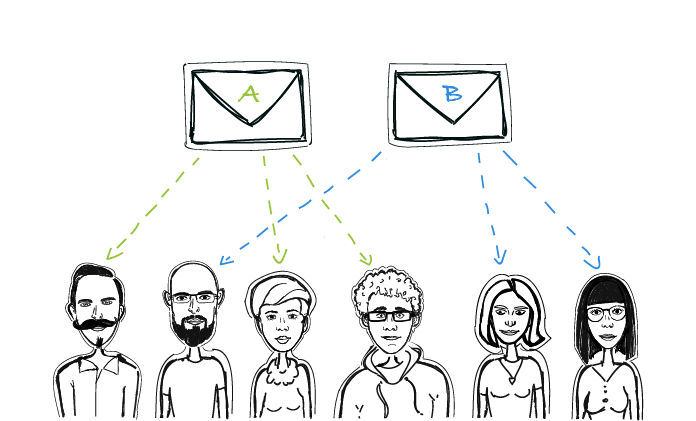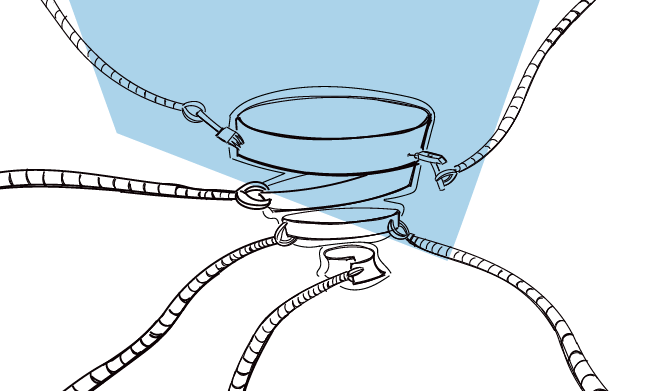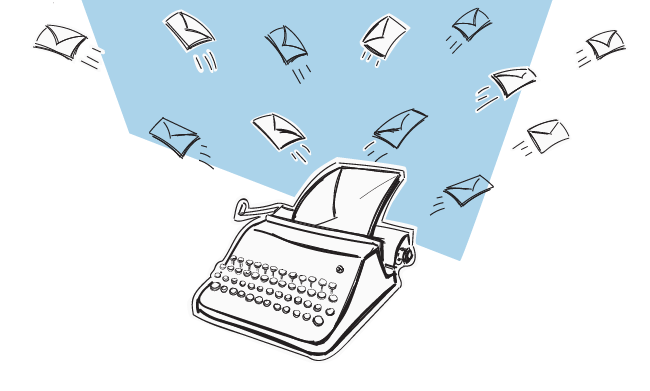Cold email copy can make or break your email campaign. A perfectly targeted prospect base won’t guarantee success if your message doesn’t catch their interest. Unfortunately, many cold emails fail to do that.
The most common problems with cold email copy that I’ve come across are the lack of clarity, impersonality, unnecessary wordiness and egocentrism. These things make prospects delete the message without even reading it till the end.
In this blog post, I want to share with you some copywriting tips that will help you write more prospect-oriented, valuable and engaging sales emails that will get opened, read and replied to.
TIP #1 Have your prospects and their goals in mind
Among your prospects are small, medium and big companies that may belong to different industry niches or come from various parts of the world. The same message won’t resonate equally with an owner of a rising tech startup and a business development manager in a digital agency employing 200 people. They have different needs and face different challenges at work.
For your email to hit the right chord, it should be tailored to the specific group it’s targeted at. That’s why before you sit down to write a cold email, you thoroughly analyze your prospect base and divide it into more narrow and homogeneous segments.
Smaller, but more targeted campaigns increase the chance that your message will win your addressees’ attention as it will fit the context better. Your prospects will be able to identify themselves with the needs or challenges addressed in your email. Thus, your product presented as a solution or improvement has a higher chance to capture their interest.
TIP #2 Apply problem-solution pattern to your cold sales email copy
This is a well-known marketing method that works well in cold emailing too. Try to paint two pictures in your prospect’s mind: one of how their business or daily work looks like now and another one of how much better, easier or more efficient it could become. Show the potential that is within their reach. In this story, your product or service should have a minor role as a means to achieve their goals.
Here’s an example of a problem-solution pattern from an email targeted at rising SaaS companies:
“To maintain a steady business growth and reduce churn, your company needs to implement a scalable client onboarding process without losing a human touch. That’s a tricky thing for a small team – we’ve been there too.
That’s why we came up with a tool to make the process more efficient and maintain a high level of personalization at the same time.”
This cold sales email copy fragment refers to the problem of fighting churn, which is quite a challenge for new SaaS companies. The solution provided is a scalable personalized client onboarding process. Note that the product is mentioned here only as a means to implement the process more efficiently. In small teams, the efficiency is quite crucial, though and that’s what may additionally spark up your prospect’s interest in your product. That’s your product’s value proposition for this particular customer segment.
And this leads us to the next tip…
TIP #3 State your value proposition clearly
Coming up with an on-point value proposition requires deep knowledge about your customers’ business and all the challenges it entails. A value proposition should depict your product as an answer to their needs. It’s a tricky task, though. There’s a trap of coming out too salesy or making the value proposition too blurry and not convincing enough.
What’s the secret sauce, then? First and foremost a value proposition should be prospect-centered and of importance to your addressee. It should showcase your product as a means to achieve their goals or solve an actual problem. Even though your product may be a solution to many problems, try to focus on one to make your value proposition specific. Base on what you’ve learned about your target segment and their business while prospecting.
Here you’ll find some examples of good value propositions you can get inspired with while writing your own emails: Value Proposition – How to Tell My Addressee What I Want from Them? >>
TIP #4 Speak the language of benefits
In order to give your value proposition a helpful tone and avoid sounding salesy, you must translate your product’s features into benefits for a customer.
Putting too much emphasis on a product’s features is one of the most common mistakes in cold emailing. Your addressees most likely never heard of your product, so don’t bore them with a long list of its features. Instead, tell them what they can achieve with it and how it will improve their business or workflow.
Here’s an example. Let’s say that your product is a data enrichment software. Users import their leads’ email addresses to it and get their data profiles. Using the language of benefits you can put it this way: Save time on manual research and get deep insights on your leads with one click. Or this way: Use deep insights on your leads to personalize your sales conversations.
It’s not that tricky. All you have to do is get in your potential customers’ shoes and think like them for a while.
Here’s more about how to translate your product’s features into benefits without sounding salesy: Features vs. Benefits – How to Present Your Product in a Cold Email? >>
TIP #5 Ask open-ended questions
The aim of a sales email is to engage prospects in a conversation to further develop a relationship with them. Open-ended questions work great as conversation hooks. They give a lot of space for a prospect to talk more about their business, the challenges they face, and the needs they have. This way you can understand your prospect’s business better.
What open-ended questions can you ask to spark a conversation? Here are a few examples:
- What challenges do you have with X?
- How do you handle X in your team?
- What are your thoughts about X?
- Do you have a process concerning X? Is it effective?
And so on. You’ll find more examples in this blog post:A Guide to Asking Open-Ended Questions in Sales Emails >>
Don’t go overboard with questions, though. That’s not an interrogation. Listen to your prospects and draw conclusions from their answers to smartly lead the conversation towards closing the deal.
TIP #6 Avoid clichés and catchphrases
Clichés are what makes people roll their eyes every time they come across one. Some phrases became so worn out over time they simply don’t work anymore. Even worse – they irritate the recipients. Make sure that your cold sales email copy is cliché-free.
Here you’ll find some examples of what phrases better to avoid in sales emails:
Cold Email Clichés, or What Prospects Have Seen Too Many Times to Care >>
TIP #7 Personalize your cold sales email copy
Personalization in sales emails is important for two important reasons. Firstly, because nobody likes getting impersonal messages. Secondly, because generic, copy-paste-type of messages will kill your deliverability in the long run. Spam filters are alert to identical emails and treat such messages as spam.
Your emails should be personalized at least at a basic level, that is, they should include your prospect’s name and their company’s name at a minimum. However, our research indicates that the higher the level of personalization, the better the results of a campaign. That’s a good enough reason to devote a bit more time to personalization, isn’t it?
Apart from a prospect’s first name and their company’s name, you can sprinkle your copy with some custom snippets using the information about them that you came across while prospecting. This adds uniqueness to your email in the eyes of your addressees as well as spam filters.
Advanced snippets work great as ice-breakers too. You can start your email by mentioning an article from your prospect’s company blog that you’ve found interesting. Or mention their answer on Quora that was helpful for you. Anything that is worth pointing to.
Check this blog post for some more ideas:
How to Make My Cold Emails Personal? Vol.2: Copy >>
TIP #8 Add value to the follow-ups
I already mentioned that an email must be of value to the addressee to catch their interest. This rule applies to the follow-ups as well. Unfortunately, I’ve seen many follow-ups that looked rather like reminders that the sender is looking forward to hearing back from me.
Sure, your prospect might have forgotten to reply to your email and in this case, a reminder would be much appreciated. But in a vast number of cases, they didn’t reply because you simply didn’t manage to catch their attention. A follow-up is another chance to do that.
A sales follow-up must be logically connected with the initial email. While the opening message covers your main point, the follow-up should add some extra value. So instead of sending another “gentle reminder on a previous email”, you can add value in the following way:
- Mention a relevant case study. It may feature a prospect’s industry peer. Case studies make it easier for a potential customer to visualize the benefits of your product.
- Link to valuable content. I’m sure you have an interesting blog post series, guide or whitepaper up your sleeve.
- Invitation to an upcoming webinar that your prospects may find helpful.
These are just a few ideas that came to my mind, but there are definitely more ways in which you can make your follow-ups more valuable.
TIP #9 Use an on-point CTA
CTA is the key to boosting reply rates, so it deserves a lot of your attention. Treat it as a trigger that causes a specific action that leads to achieving your pre-defined aim, for example, a call invite or demo signup.
To be persuasive your CTA needs to be specific. Precise what you want your prospects to do. If you want to schedule a meeting with them, give the details upfront. Ask whether they’re available for a 15-minute call on Thursday morning instead of inquiring whether they have time for a quick chat. If you want them to sign up for a trial, give clear and short instructions on how to do that in the easiest possible way.
Learn more about how to write an on-point CTA:
Perfect CTA, or How to Write a Persuasive Email? >>
TIP #10 Always check your cold sales email copy for SPAM words and errors
Before hitting “send”, make sure your emails are spam-word-free. Certain words have been so overused by spammers, that spam filters block emails containing them. If your open rate is plummeting, there’s a chance your messages land in the SPAM folder.
Although there may be some technical reasons for this to happen too, the first thing worth checking is whether your cold sales email copy includes any suspicious words. Check it again for a list of common spam words, like this one.
Last thing is to check your cold sales email copy for any spelling or grammatical errors. Bad grammar may ruin your first impression on the recipients. Errors don’t make you look professional. Always spell-check the email content with a text editor or an online tool of your choice, for example, Grammarly.
Back to you
Mastering the art of writing a perfect cold sales email copy takes time. The key to success is to take the perspective of your prospects, add value, be concise and personalize the message.
I hope these tips will help you enhance your email writing skills. Good luck!
FAQ Section
1. How can effective cold email copywriting address the pain points of the target audience to improve response rates?
Effective cold email copywriting addresses the pain points of the target audience by first identifying and understanding those challenges through research and insights into the target market. By crafting the email content to specifically highlight solutions to these pain points, and incorporating social proof such as testimonials or case studies, businesses can demonstrate their understanding and capability to address these issues. Personalizing the email to reflect the recipient’s specific situation or industry further enhances the relevance of the message, making the potential client more likely to engage and respond.
2. What role does the subject line play in the success of cold email campaigns, and how can it be optimized to increase open rates?
The subject line plays a crucial role in the success of cold email campaigns as it’s the first element the recipient sees and determines whether the email will be opened. To optimize the subject line for higher open rates, it should be concise, intriguing, and personalized, clearly indicating the value or benefit awaiting the recipient inside. Using action-oriented language or posing a question that resonates with the recipient’s pain points or interests can also make the subject line more compelling. Testing different subject lines in your cold email outreach can help identify what works best for your target audience.
3. In what ways can incorporating a follow-up email sequence into your cold email campaign strategy enhance overall effectiveness?
Incorporating a follow-up email sequence into your cold email campaign strategy enhances overall effectiveness by maintaining engagement with recipients who didn’t respond to the initial email. Follow-up emails provide an opportunity to reiterate your value proposition, address additional pain points, or offer new information that might capture the recipient’s interest. A well-structured follow-up sequence can keep the conversation going, increasing the chances of converting a recipient into a potential client by consistently reminding them of your presence and the solutions you offer.
4. How can personalized cold emails and email signatures contribute to building trust and credibility with potential clients?
Personalized cold emails contribute to building trust and credibility with potential clients by demonstrating that you have taken the time to understand their specific needs, challenges, and interests. Customizing the email content, including the use of the recipient’s name, company name, or referencing specific website traffic or organic search traffic challenges they might be facing, shows a level of care and attention that generic emails lack. Similarly, a professional email signature that includes your contact details, position, and company name adds a layer of authenticity and professionalism, making it easier for recipients to verify your identity and the legitimacy of your outreach.
5. What are the key elements to include in a cold email template to ensure it resonates with the target audience and prompts action?
Key elements to include in a cold email template to ensure it resonates with the target audience and prompts action include:
- A compelling subject line that grabs attention and hints at the email’s value.
- An opening line that personalizes the message and immediately engages the recipient in cold emailing subject line.
- A brief introduction that clearly states who you are and the purpose of your email (e.g., cold email outreach with various subject lines)
- A concise explanation of how your product or service addresses the recipient’s pain points, including social proof where possible.
- A clear and direct call to action that specifies what you want the recipient to do next, whether it’s replying to the email, scheduling a call, or visiting a webpage.
- A professional email signature that provides your contact information and reinforces your credibility. Ensuring these elements are crafted thoughtfully and tailored to the specific needs and interests of your target audience can significantly increase the effectiveness of your cold email campaign.
READ ALSO

A/B Testing in Cold Email: How to Optimize Our Copy to Get More Replies?
Split tests, or A/B tests, are a well-known method for website’s or newsletter’s copy optimization. But cold email copy also needs constant changes if it is to bring optimal effects. Here’s a little about split testing in cold email: which parts of our email can be tested, how can we test most effectively, what tools can we use for convenient comparison of results?

How to Build a Sales Pipeline to Turn Your Outbound Leads into Customers?
In business, nothing can be left to chance. Otherwise, you won’t make much progress. When it comes to sales, in order to turn more leads into customers, you need to set your internal guideposts that will make the whole process more effective. That’s what a sales pipeline is at its core. Let me show you how to build a sales pipeline from scratch following this six-step tutorial.

How to Use Social Listening Tools to Better Personalize Your Cold Outreach?
Personalization is one of the golden rules of cold emailing. Throughout this blog, you’ll find many arguments behind using personalized snippets in your email copy. The more personalized it is, the higher the chance of getting a reply.

